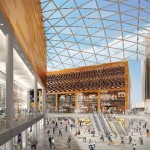Where do people go shopping, spend time with friends and family, or watch a film? Do they prefer to stay in, go out, or a mixture of the two? Whatever their preferences are, they are likely to have a lot more choices available now than five, let alone ten, years ago.
New developments in technology, retail, and leisure have undoubtedly transformed how and where people spend their free time and money. And when it comes to retail, the figures around the continued growth of online shopping are all too familiar. But whether online or offline, there will always be much more to a truly satisfying shopping experience than simply shopping.
A 2015 report by Savill’s, “Megatrends: What lies ahead for the European retail industry?” predicts that, while 20 to 25% of all retail spend is likely to be generated online in 10 years’ time, the largest share of retail activity will still take place in physical shops. From intu’s research and conversations with customers, the company knows that the drive for shopping center visits is now fueled as much by a desire to spend quality time with friends and family, perhaps over a meal, drink, or a movie, as it is by retail. Remaining digitally connected and online is also key to the consumer’s experience and an important way in which they now interact with all kinds of different brands.
Changing expectations
So, with the consumer now weighing up a visit to a shopping center with a visit to a local tourist attraction, family activity, or an online shopping experience, it’s become vital to invest time and money in creating genuine retail and leisure destinations that are right for these changing expectations. The best centers are already investing in new leisure, dining, and digital opportunities to create the right spaces for retailers and customers and this, in turn, helps to increase dwell time, engagement, and the overall catchment area. More choice and convenience mean more reasons to visit and for longer and this delivers sales for all tenants.
For example, intu worked with Apple to map the company’s centers digitally, which, along with their high-quality Wi-Fi infrastructure, has allowed it to build a uniquely personalized way-finding and offers the app that is now being rolled out across all intu-branded centers. Plus, as the only shopping center landlord with an in-house digital innovation team, intu was also the first in the industry to introduce a transactional website that provides 350 retailers another route to market and shoppers with 24/7 shopping from intu’s retailers.

This important work to create more digitally connected centers is taking place alongside new investment in the best physical spaces for retailers and customers, such as the multi-million-pound investment at intu Watford. The center has been at the heart of Watford for 25 years, but now work has started to create a new extension that will include exciting new brands and restaurants, anchored by a nine-screen Cineworld Imax cinema and Debenhams. As well as enhancing the night-time economy in this affluent catchment across north London and Hertfordshire, it is predicted to promote Watford to the CACI’s top 20 national retail destination ranking, alongside Edinburgh and Bristol.
Expanding leisure offers

intu Watford is one of three major projects in which intu is investing £350 million (€437 million) over the next three years, which will significantly expand its leisure offer to customers. Transformational developments like this will also bring a cinema, dining, and new retail brands to intu Broadmarsh in Nottingham and an innovative 21,000-sq-m leisure extension at intu Lakeside, with construction work on both, due to start this year.

This follows hot on the heels of work to make intu Potteries in Stoke-on-Trent the major shopping and leisure destination for people living and working in Birmingham and Manchester. The first phase of this project, a £19-million, 6,500-sq-m leisure extension of seven quality restaurants and a nine-screen cinema, opened to the public at the beginning of December 2015. Its impact was immediate, with footfall rising by 28% in the first few weeks after opening; a rise in sales, with one retailer taking 30% more than in the same period the previous year; and a number of brands clamoring to take space or upsize their stores as a result.

Continuing to attract customers to intu’s shopping centers is ultimately about developing spaces and technology in this way to create better and more relevant shopping experiences. Landlords need to employ the power of digital technology to mirror retailers’ own multichannel strategies, give customers compelling experiences that surprise and delight, and provide the right leisure and dining opportunities to compete against the best tourist attractions.
Within a world of rapidly changing consumer choice and expectations, the experts at intu firmly believe that shopping center landlords still have a vital role to play. In fact, every sign shows that, as long as shopping centers continue to adapt to changing consumer demands and invest accordingly, the insatiable demand for the physical shopping trip is likely to continue and even strengthen in future years.





